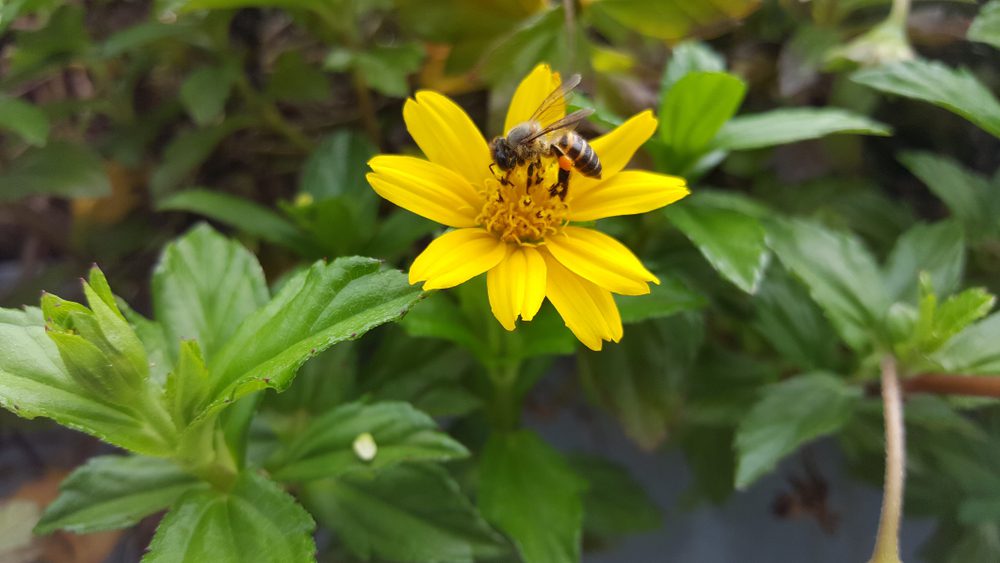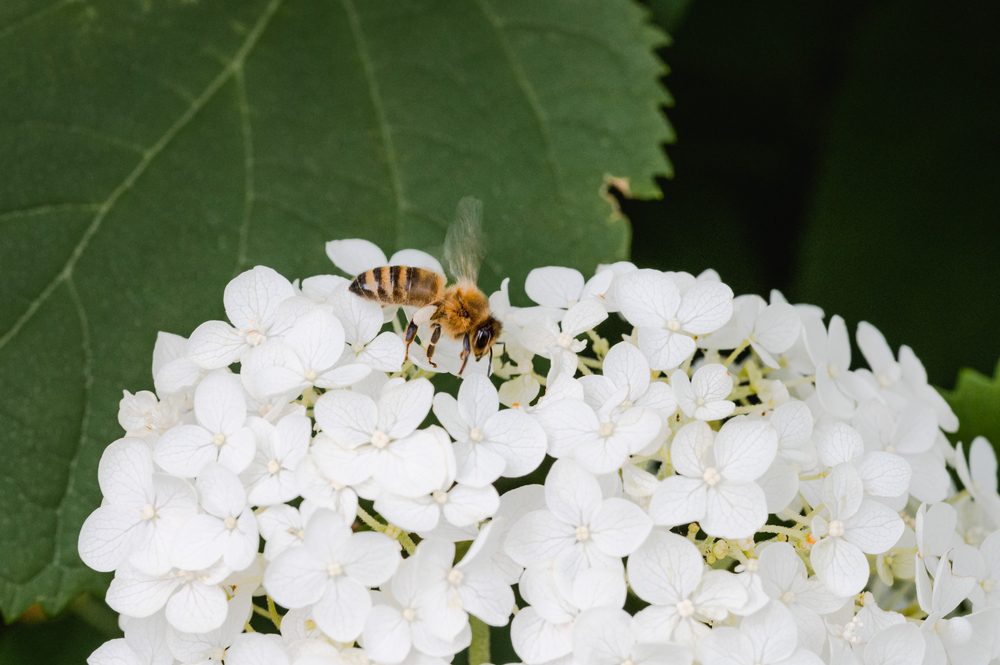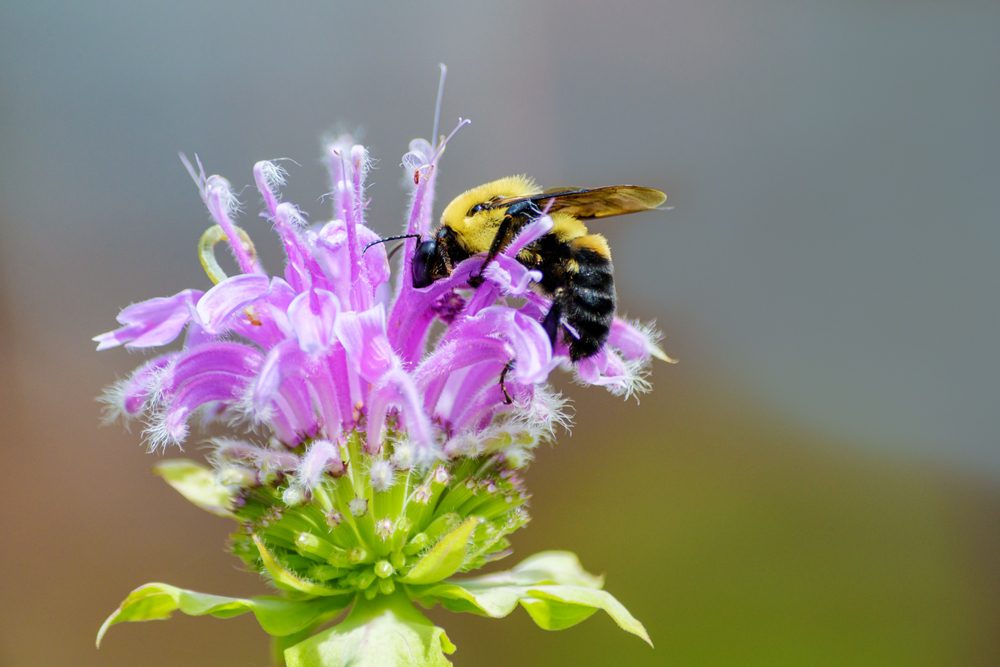Pollinator plants attract a range of pollinators, but most especially bees! Chicago area bees are responsible for many of the flowers and foods that we eat. Did you know that 80 percent of the world’s flowering plants need a pollinator to reproduce, and about 30% of our food is created with the help of pollinators?
We need pollinators for everything from fruits and vegetables to nuts and spices. Filling your garden with pollinator plants can help ensure that your flower garden and vegetable garden will be a success. In this article, we’ll talk about the 25 best pollinator plants for your garden. We’ll discuss popular perennials as well as annuals that can help attract pollinators to your garden.
The Best Plants for a Pollinator Garden
1. Calamint
Calamintha nepeta, also known as lesser calamint, is a fantastic pollinator plant due to its abundant, long-lasting blooms. From summer to fall, it attracts bees, butterflies, and other beneficial insects with its minty fragrance and nectar-rich flowers. Its compact size and easy care make it perfect for garden beds or borders. Plus, it’s drought-tolerant, making it a low-maintenance way to support local pollinators!
2. Basil
Basil is a fantastic pollinator! Once basil starts to produce large flowers, the leaves can become bitter or lose their flavor, but that doesn’t have to stop you from consuming basil. Basil flowers are edible, just like the leaves. Consider including basil flowers in your salads, but don’t forget to leave some buds in your garden to attract pollinators.
3. Bee Balm
Bee balm attracts a range of pollinators, not just bees! These funky, quirky flowers can attract butterflies and hummingbirds as well. Bee balm plants go by many names including horsemint, bergamot, and Oswego tea. In the past, bee balm has been used to treat bee stings (hence the common name bee balm). This plant is a prized garden perennial because it’s easy to grow and produces impressive flowers year-round.
4. Button Bush
Do you have uncommonly wet soil on your property? Want an unusual flowering plant for your home landscape? The button bush may be the perfect flower type for you. This distinctive shrub has spherical button-shaped flowers that attract pollinators. Button bush doesn’t grow well on dry soil, so this is a good option for the area around your dry creek bed.
5. Chokeberry
Chokeberry shrubs have ornamental qualities at various times throughout the year, including spring when they boast beautiful white flowers, and in fall, when they produce berries (either red or black). The berries are tart (but not poisonous), so birds tend not to eat them, and they remain on the bush for a long time, adding color to the landscape. Chokeberry can be used in canning for jams and jellies.
6. Cilantro
Cilantro makes a great addition to some dishes, but if you allow the plant to produce its beautiful white flowers, it will draw bees and other pollinators to your space. Cilantro grows best in full sun or light shade, with well-draining soil. It’s a small plant that can be grown on the edges of your garden to attract pollinators. If you like the herb, set aside some to be used in cooking.
7. Coreopsis (Tickseed)
Coreopsis is a member of the daisy family, producing long-lasting blossoms on long, slender stems. Coreopsis spreads naturally through seed and rhizomes, and is easy to care for, requiring watering throughout the summer and little else. Occasional deadheading will encourage this plant to produce flowers throughout the growing season. Coreopsis flowers come in a range of colors including yellow, red, white, and pink.

8. Cosmos
Cosmos are daisy-like flowers that come in a variety of colors including yellow and pink. This self-seeding plant comes back year after year and attracts butterflies. With long-lasting blossoms, cosmos add color and good cheer to your flower garden. Plant cosmos with a range of other daisy-like flowers including cone flowers or coreopsis, to create a prairie-like beauty for your landscape.
9. Dill
Dill produces bushy, edible plants that are a favorite of both pollinators and caterpillars. Bees and butterflies love its delicate yellow flowers, while caterpillars—especially swallowtails—enjoy munching on its leaves. To ensure enough for both you and the wildlife, consider planting a little extra! Dill grows best in well-drained, low-fertility soils with plenty of sun. Sow seeds continuously throughout the growing season for a steady harvest and pollinator activity.
10. Coneflower (Echinacea)
Coneflower has many excellent qualities that make it a long-standing staple of gardens throughout the Midwest. It produces long-lasting flowers that can be seen from early summer until fall. Once established, coneflower is resistant to drought. It tolerates a range of environments including full sun and partial shade, and it’s a perennial plant, so once it’s in place, you can enjoy it for years to come.
11. False Indigo
False indigo attracts hummingbirds to your garden, especially after a few seasons of good growth. In the first two seasons, false indigo does much of its developing beneath the ground. It’s only after these two seasons that your false indigo will start to show its most beautiful blooms. This shrub produces lovely flowers that will do more than attract hummingbirds – they’ll also catch your eye.
12. Ageratum (Floss Flower)
Floss flower is a tender annual that reseeds itself well, so planting it once will continue to produce flowers for a long time to come. Floss flower’s tufted blossoms can be scattered throughout your garden bed and will flower from late spring through fall. Plant floss flower for long-lasting color in your garden bed. Consider planting floss flower near yellow zinnia for a blast of yellow and purple color to attract pollinators of all types.
13. Goldenrod

Although sometimes dismissed as a weed, goldenrod is a North American perennial plant that has been used in the past for a variety of purposes including making tea and treating certain conditions. It is very attractive to pollinators. While goldenrod is sometimes blamed for allergies, it produces large clumps of pollen that does not carry on the wind. For most people, it is not an allergen.
14. Lavender
This drought-tolerant perennial shrub produces beautiful purple flowers that are both fragrant and beautiful when dried. Lavender plants last approximately 10 years and then need replacement. Cut lavender back to about 6 inches every few years to prevent it from getting scraggly. Lavender can be used in cooking, or you can dry lavender and place it in a vase in your home. Lavender is grown best in soils with poor fertility.
15. Lemon Balm
Lemon balm is a plant in the mint family which will produce attractive flowers if allowed. Lemon balm’s minty leaves have a distinctive lemon flavor. Once the plant has flowered, this flavor gets weaker. You can use lemon balm in your salads or fruit salads to add a zesty flavor, or allow it to produce blossoms to attract those pollinators like bees and butterflies.
16. Marigolds
Marigolds are a favorite annual plant that appears in flower beds throughout the Midwest. Favored for their easy growth and long-lasting blooms, marigolds are also great for repelling certain pests like deer, which find marigold blossoms to have an unpleasant odor. Marigolds come in a range of colors including yellow, orange, and red. The blossoms tend to get bigger and more beautiful as the summer goes on. Keep deadheading them to encourage blooming.
17. Milkweed
Common milkweed is a herbaceous wildflower that produces small flowers that grow in clusters. Milkweed grows up to 5 feet tall and needs full sun throughout the summer. Milkweed attracts all types of pollinators including butterflies and bees, and is also a larval host plant for monarch butterflies.
18. Peppermint or Spearmint
Peppermint and spearmint are excellent additions to any pollinator garden. Their small, fragrant flowers are magnets for bees, butterflies, and other beneficial insects. These hardy, fast-growing herbs thrive in full to partial sun and well-drained soil. Be sure to plant them in containers or a designated area, as they can spread quickly. As a bonus, their leaves are great for culinary uses, making them a multi-purpose addition to your garden!
19. Sunflowers
This easy to grow flower is a self-seeding flower that attracts pollinators and then birds as their blossoms open and develop. Sunflowers are known for following the sun in its trajectory across the sky, and produce large, cheerful, shaggy blossoms that are a staple of late summer gardens.
20. Parsley
Parsley has good flavor and is easy to grow in an herb garden. If you grow more parsley than you need, allow it to flower to attract pollinators. Plus, parsley is a favorite food source for caterpillars, so planting a little extra can help support their growth. Parsley grows best from seeds planted in rich soil.
21. Summersweet
Summersweet is a flowering shrub that produces spears of flowers in July and August. Its fragrant scent is a joy for people and, once established, it can tolerate short periods of drought. Summersweet attracts pollinators of all types and when fall rolls around, the leaves turn a decorative yellow for lovely fall color.
22. Hydrangea
Hydrangeas are a favorite for traditional gardens, especially the paniculata types like Pinky Winky or Quickfire. These open panicle flowers attract pollinators like bees and butterflies while adding beautiful color to your landscape. With large clusters of white, pink, or soft red blooms, they brighten any garden. Hydrangea shrubs vary in size, so choose carefully to ensure they fit your space. Paniculata hydrangeas thrive in sun to partial shade.

23. Veronicas
This perennial plant produces charming purple flowers that attract pollinators. Although they can grow in partial shade areas, you’ll get the most flowers with limited water and full sun. Plant veronicas in places where it’s hard to get other flowers to grow, like narrow beds near pathways or spaces your sprinklers don’t quite reach.
24. Bluebeard
Bluebeard is a low-mounding shrub that produces fluffy, cloud-like flowers. This plant blooms in late summer and early fall, and attracts pollinators of all types. Too much fertilizer will produce lanky growth, so use fertilizer sparingly.
25. Zinnias
Zinnias are prolific bloomers and a favorite annual plant in many summer gardens. These colorful flowers come in different types including single, double, and semi-double, so you can choose the variety of zinnia that you prefer.
What is a Pollinator?
A pollinator is anything that helps disperse pollen throughout gardens. Pollinators help promote flowering and fruit production, and in many cases, are an essential part of the production cycle.
While there has been much talk in the news over the last several years about the decline of the European Honeybee, this is not a native bee. There are over 4,000 species of native bees in North America, and all of them are important to our food cycle.
What are Pollinator Plants?
Pollinator plants are plants that attract pollinators. Pollinator-friendly plants have sweet pollen that pollinators want for their food. There are a variety of blooming perennials that attract perennial pollinators. If you’re interested in buying plants for a pollinator garden, we can help.
What Attracts Pollinators to Plants and Flowers?
There are many visual cues you can use when trying to identify pollinators. Pollinators typically have showy blossoms and sepals. These plants often have blossoms in bright colors like red or purple. The best way to identify good pollinator plants or pollinator plants for bees is to ask the experts when you’re shopping at Platt Hill Nursery.
Find Your Pollinator Plants at Platt Hill Nursery!
Platt Hill Nursery carries a range of pollinator plants including the best pollinator plants for vegetable garden spaces. We sell zone 5 perennials and a range of products to make your perennial garden a success. To find the perennial or annual plants of your choice, search our plants on our website or contact the experts at Platt Hill Nursery directly.


